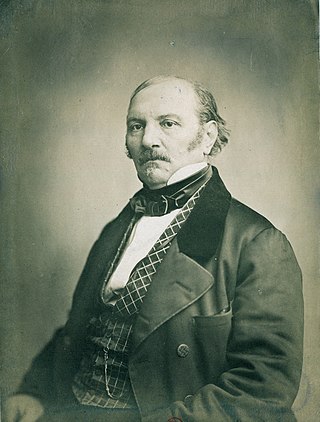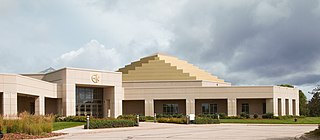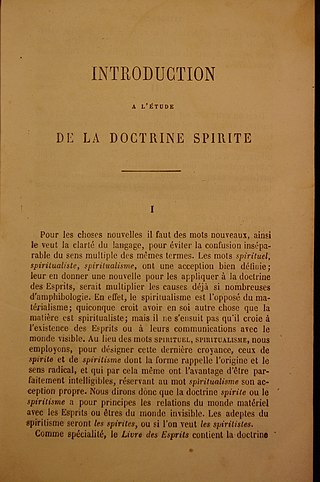
Reincarnation, also known as rebirth, transmigration, or in Ancient Greek-inspired texts metempsychosis, is the philosophical or religious concept that the non-physical essence of a living being begins a new life in a different physical form or body after biological death. In most beliefs involving reincarnation, the soul of a human being is immortal and does not disperse after the physical body has perished. Upon death, the soul merely becomes transmigrated into a newborn baby or an animal to continue its immortality. The term transmigration means the passing of a soul from one body to another after death.

Spiritism, spiritist doctrine, Kardecism or Kardecist spiritism is a reincarnationist doctrine established in France in the mid-19th century by the author and educator Allan Kardec. It explains, from a Christian perspective, the cycle by which a spirit supposedly returns to material existence after the death of the old body in which it dwelled, as well as the evolution it undergoes during this process. The concept also interacts with philosophical and scientific conceptions of the relationship between the physical and the moral. Kardecism emerged as a new religious movement out of spiritualism, the notions and practices associated with spiritual communication disseminated throughout North America and Europe since the 1850s.

Spiritualism was a social religious movement in the nineteenth century, according to which an individual's awareness persists after death and may be contacted by the living. The afterlife, or the "spirit world", is seen by spiritualists not as a static place, but as one in which spirits continue to evolve. These two beliefs—that contact with spirits is possible, and that spirits are more advanced than humans—lead spiritualists to the belief that spirits are capable of providing useful insight regarding moral and ethical issues, as well as about the nature of God. Some spiritualists will speak of a concept which they refer to as "spirit guides"—specific spirits, often contacted, who are relied upon for spiritual guidance. Emanuel Swedenborg has some claim to be the father of Spiritualism. Spiritism, a branch of spiritualism developed by Allan Kardec and today practiced mostly in Continental Europe and Latin America, especially in Brazil, emphasizes reincarnation.

Eckankar is a new religious movement founded by Paul Twitchell in 1965. The spiritual home is the Temple of ECK in Chanhassen, Minnesota. Eckankar is not affiliated with any other religious group.

Umbanda is a religion that emerged in Rio de Janeiro, Brazil in the 1920s. Deriving largely from Spiritism, it also combines elements from Afro-Brazilian traditions like Candomblé as well as Roman Catholicism. There is no central authority in control of Umbanda, which is organized around autonomous places of worship termed centros or terreiros, and is broadly divided between White Umbanda, which is closer to Spiritism, and Africanized Umbanda, which is closer to Candomblé.

The predominant religion in Brazil is Christianity, with Catholicism being its largest denomination.

Eduard Albert Meier, commonly nicknamed "Billy", is the founder of a UFO religion called the "Freie Interessengemeinschaft für Grenz- und Geisteswissenschaften und Ufologiestudien" and alleged contactee whose UFO photographs are claimed to show alien spacecraft. Meier claims to be in regular contact with extraterrestrial beings he calls the Plejaren. He also presented other material during the 1970s such as metal samples, sound recordings and film footage. Meier claims to be the seventh reincarnation after six prophets common to Judaism, Christianity, and Islam: Enoch, Elijah, Isaiah, Jeremiah, Immanuel (Jesus), and Muhammad.

Shugendō is a highly syncretic religion, a body of ascetic practices that originated in the Nara Period of Japan having evolved during the 7th century from an amalgamation of beliefs, philosophies, doctrines and ritual systems drawn from local folk-religious practices, Shinto mountain worship and Buddhism. The final purpose of Shugendō is for practitioners to find supernatural power and save themselves and the masses by conducting religious training while treading through steep mountain ranges. Practitioners are called Shugenja or Yamabushi. The mountains where shugenja is practiced are all over Japan, and include various mountains of the Ōmine mountain range such as Mount Hakkyō and Mount Ōmine.
The Aetherius Society is a new religious movement founded by George King in the mid-1950s as the result of what King claimed were contacts with extraterrestrial intelligences, to whom he referred as "Cosmic Masters". The main goal of the believer is to cooperate with these Cosmic Masters to help humanity solve its current Earthly problems and advance into the New Age.

Santo Daime is a syncretic religion founded in the 1930s in the Brazilian Amazonian state of Acre by Raimundo Irineu Serra, known as Mestre Irineu. Santo Daime incorporates elements of several religious or spiritual traditions including Folk Catholicism, Kardecist Spiritism, African animism and indigenous South American shamanism, including vegetalismo.

Antoinism is a healing and Christian-oriented new religious movement founded in 1910 by Louis-Joseph Antoine (1846–1912) in Jemeppe-sur-Meuse, Seraing in Belgium. With a total of 64 temples, over forty reading rooms across the world and thousands of members, it remains the only religion established in Belgium whose notoriety and success has reached outside the country. Mainly active in France, the religious movement is characterized by a decentralized structure, simple rites, discretion and tolerance towards other faiths.

The Spirits' Book is part of the Spiritist Codification, and is regarded as one of the five fundamental works on Spiritism. It was published by the French educator Hippolyte Léon Denizard Rivail, under the pen name of Allan Kardec on April 18, 1857. It was the first and remains the most important Spiritist book, because it addresses in first hand all questions developed subsequently by Allan Kardec.
Tia Neiva was a Brazilian medium and founder of the mystical community Vale do Amanhecer located in the Planaltina, Federal District, Brazil.
A Spiritist centre, also called Spiritist society or Spiritist house, is the basic unit of organisation of Spiritism, which is a distinct form of Spiritualism.

Espiritismo is a term used in Latin America and the Caribbean to refer to the popular belief that evolved and less evolved spirits can affect health, luck and other aspects of human life.
Spiritualism is a metaphysical belief that the world is made up of at least two fundamental substances, matter and spirit. This very broad metaphysical distinction is further developed into many and various forms by the inclusion of details about what spiritual entities exist such as a soul, the afterlife, spirits of the dead, deities and mediums; as well as details about the nature of the relationship between spirit and matter. It may also refer to the philosophy, doctrine, or religion pertaining to a spiritual aspect of existence.

The National Spiritualist Association of Churches (NSAC) is one of the oldest and largest of the national Spiritualist church organizations in the United States. The NSAC was formed as the National Spiritualist Association of the United States of America (NSA) in September 1893, during a three-day convention in Chicago, Illinois. Although American Spiritualists had previously tended to resist institutional or denominational organization, early NSA leaders hoped organization would help promote the truths of the religion both spiritually and practically. Organization could help non-Spiritualists distinguish genuine mediumship from the rapidly proliferating varieties of fraudulent mediumship, increase communication among Spiritualists, prevent the legal prosecution of spirit mediums under fortune telling and medical licensing laws, and counterattacks by "orthodox" ministers in the press. To these reasons, early leaders added the material support of spirit mediums and healers, just as other religious groups provided for the support of their clergy.

Around the World in 80 Faiths is a British television series which was first broadcast by the BBC on 2 January 2009. The series was presented by Anglican vicar Pete Owen-Jones, who was researching the various faiths from around the world.

Yemọja is the major water spirit from the Yoruba religion. She is the mother of all Orishas. She is also the mother of humanity. She is an orisha, in this case patron spirit of rivers, particularly the Ogun River in Nigeria, and oceans in Cuban and Brazilian orisa religions. She is often syncretized with either Our Lady of Regla in the Afro-Cuban diaspora or various other Virgin Mary figures of the Catholic Church, a practice that emerged during the era of the Trans-Atlantic slave trade. Yemọja is said to be motherly and strongly protective, and to care deeply for all her children, comforting them and cleansing them of sorrow. She is said to be able to cure infertility in women, and cowrie shells represent her wealth. She does not easily lose her temper, but when angered she can be quite destructive and violent, as the flood waters of turbulent rivers. She is the creator of “human bodies” along with her partner Obatala.Yemoja might be an evolution of the Orisha Yemoo.
Janell Shirtcliff is an American filmmaker, photographer, and music video director. She also worked as a model for a decade and has done some acting for which she has been praised. She made her film directorial debut with 2021's Habit. Her photography has been featured in publications including Variety, Billboard, Nylon, and Teen Vogue.














